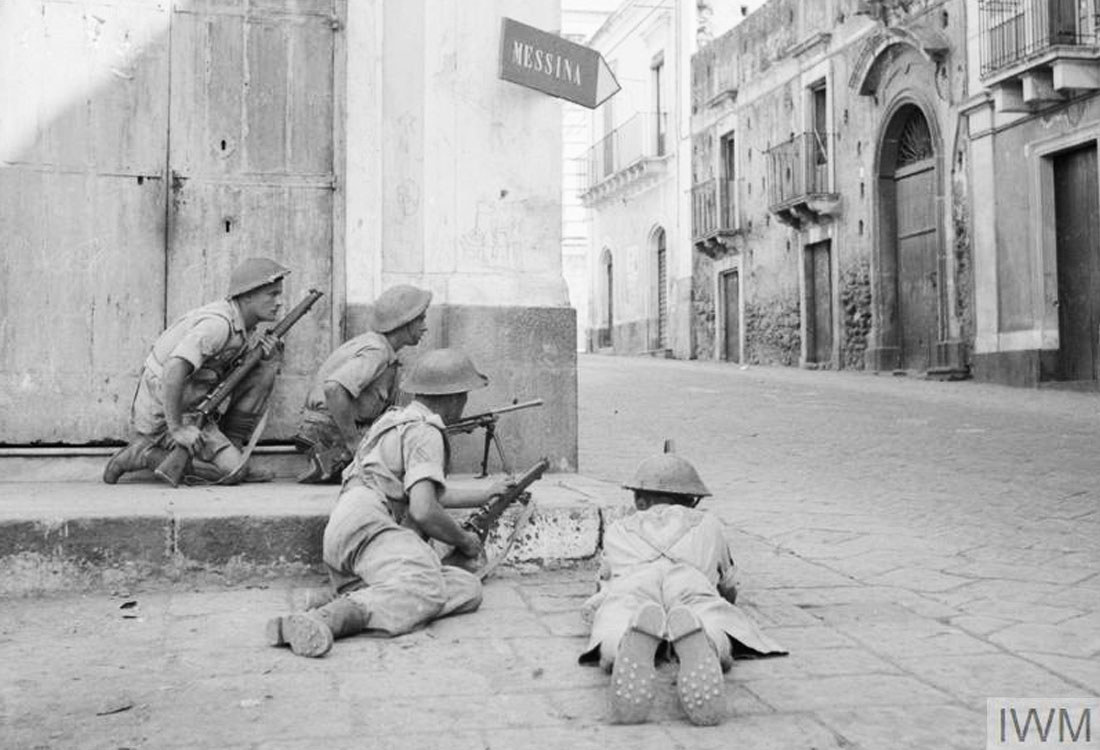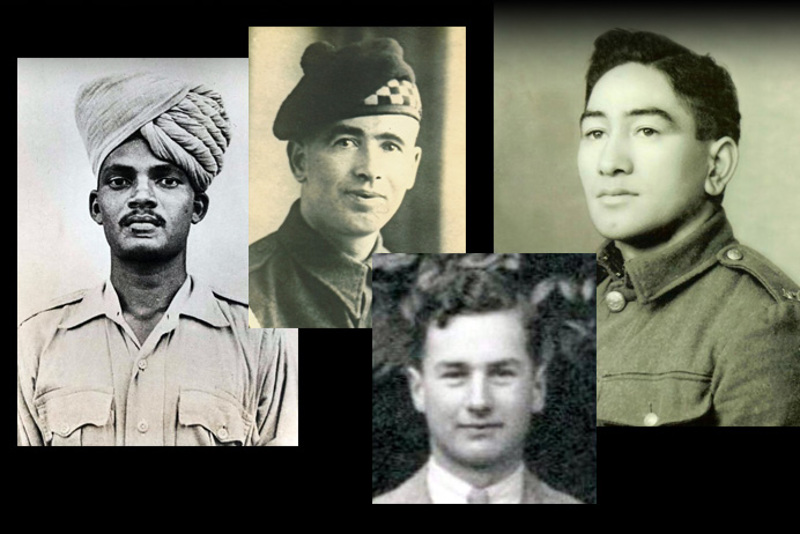
The Italian Campaign

Men of the 9th Durham Light Infantry fighting in Acireale, Sicily, 8 August 1943.
On 10 June 1940, Fascist Italy declared war on France and Britain. Over the next three years Commonwealth and Italian forces fought at sea, in the air, and on land, most famously in North Africa. After years of desert fighting, in early 1943 the German and Italian forces in North Africa were finally defeated.
On 10 July 1943, a vast armada of almost 2,600 ships landed over 180,000 Commonwealth and American troops on Sicily. Fifteen days later the Italian leader, Benito Mussolini, was arrested, and a pro-Allied government took power. Most Italian troops on Sicily offered little resistance from then on and in mid-August the island was secured.
Though the Allies had incurred fewer casualties than anticipated, the experience of fighting across Sicily was a foretaste of what was to come. The rugged countryside proved ideal for defence and a relatively small German force had fought with skill and tenacity before successfully escaping across the Straits of Messina.
The Italian Surrender

Salerno, Italy, 9 September 1943 (Operation Avalanche), British troops and vehicles are unloaded onto the beaches.
In early September 1943, the Allies landed on the Italian mainland in Operations Avalanche, Baytown and Slapstick. Simultaneously, representatives of the new Italian government formally made peace with the Allies. In response, German troops took tens of thousands of Italian soldiers into captivity, and many were subsequently deported to Germany as forced labourers. Others fought on alongside their German allies.

Mussolini was being held in the Apennine Mountains, but before he could be turned over to the Allies, German commandos stormed the Campo Imperatore Hotel and took him into their custody. He was established as the head of a puppet state, the Italian Social Republic. German forces took control of central and northern Italy and prepared to defend against the Allies, who now faced the task of liberating Italy and its people from German occupation.
The Battles of Cassino

Indian troops pass bomb shattered buildings on the outskirts of Cassino town.
Two Allied formations were deployed to Italy: the American Fifth Army and the British Eighth Army. Both had served in the deserts of North Africa and during the invasion of Sicily. They epitomised the multinational nature of the Allied war effort.
General Harold Alexander, in command of Commonwealth forces in Italy, led men from across the globe: Canadians, New Zealanders, Indians and South Africans, men from across the United Kingdom, and Gurkhas from Nepal. They fought alongside Polish and Free French divisions and Italian Royalist units. There was even a Brazilian Expeditionary force deployed to Italy in September 1944.
Following the Allied landings on the heel of the Italian mainland at Taranto and Salerno, the Germans slowly withdrew north, destroying bridges, railways and roads. In late December 1943, the painstaking and hard-fought Allied advance halted some 70 miles south of Rome, near the town of Cassino.
The Gustav Line

The Apennine Mountains that form the spine of the mainland forced the Allies to advance along two narrow corridors, each flanked by the sea on one side and steep mountains on the other. The Germans fought determined delaying actions to slow the Allied advance, all the while constructing a belt of formidable defences, the strongest of which was the Gustav Line.
Stretching across Italy, from the mouth of the Garigliano River in the west, through the Apennine Mountains to the mouth of the Sangro River in the east, the Gustav Line was built to be impenetrable. Taking full advantage of the imposing natural terrain the Germans built concrete bunkers, hidden gun emplacements and machine gun nests, laid thousands of mines and used miles of barbed wire.
Dug in amongst their daunting defences the Germans could dominate the valleys below, blocking any advance north. At the head of the Liri Valley and on the path of the Route 6 highway to Rome, Monte Cassino was a lynchpin of these defensive positions. On 17 January the first assaults on the Gustav Line were launched, and over the following months tens of thousands would fight in the shadow of the mountain, attempting to break through.
Operation Avenger

New Zealand armour and infantry move forward into Cassino.
The first attempts to break through at Cassino in January were costly failures. In an attempt to subdue the German forces, Allied commanders ordered a ferocious aerial bombardment to eliminate their defences. On 16 February, the Benedictine monastery which stood on Monte Cassino was largely destroyed, and in March bombers targeted the town of Cassino. Rather than reducing resistance, this eventually enabled German troops to occupy stronger positions amid the debris.
Attacking through the scrub and boulders of Monastery Hill, the 4th Indian Division suffered heavy casualties under relentless machine gun and mortar fire, while the 28th New Zealand (Maori) Battalion suffered more than 60 percent casualties fighting for control of Cassino’s railway station.
Anzio

DUKW amphibious vehicles loaded with troops and equipment come ashore at Anzio.
With the Allied offensive facing the formidable obstacle of Monte Cassino, an amphibious assault to the north at Anzio, codenamed Operation Shingle, was designed to open the way to Rome.
In the early hours of 22 January, on calm seas under clear skies, Allied forces landed almost without opposition. The British 1st Division, supported by Commandos, landed to the north, with the US 3rd Infantry Division, along with US Rangers, to the south. By midday, all of the initial assault objectives had been secured, but Allied commanders chose to consolidate their position rather than advance. Meanwhile, eight German divisions rushed to close off Anzio, surrounding the Allied forces.
A long-awaited attempt to break out from the beachhead began on 30 January. By then, German defences were well-prepared, and concentrated mortar, artillery and machine-gun fire held back the assault, while exhausted Allied soldiers clung on in hastily constructed forward positions, subjected to frequent counterattacks.
Constant tension and deteriorating weather conditions took their toll on the battle-weary soldiers, now fighting an unexpected defensive war in trenches and dugouts. Nowhere was beyond the range of German artillery and the Luftwaffe, which continuously harassed Allied shipping and soldiers alike, particularly at night. With the exposed landing zone offering little protection, movement above ground was dangerous. These conditions endured until 23–24 May, when Allied forces finally broke out from the bridgehead.
Victory at Cassino

Troops of the 2nd Polish Corps throwing grenades at the enemy during heavy fighting around Monte Cassino.
The burden of the fighting at Cassino fell on men rather than machines. Water, rations and ammunition had to be brought by hand to forward positions, while getting a hot meal, washing and shaving was often impossible. Those wounded at the frontline were particularly vulnerable and evacuating them proved perilous.
After the failure of piecemeal attacks over the preceding weeks and months, Allied commanders planned a major effort in May to finally break the stalemate. On 11 May a combined Allied offensive was launched, codenamed Operation Diadem. With the aid of reinforcements, the town and the heights were secured within a week. Men of the Polish II Corps raised their flag above the ruins of the monastery on 18 May, and Allied forces linked up in the Liri Valley.

Monte Cassino Monastery a day after it was captured by the 2nd Polish Corps.
Losses
The Allies lost over 50,000 men killed and wounded at Cassino, and more than 2,000 of the Commonwealth servicemen laid to rest at Cassino War Cemetery died during the final efforts to take Monte Cassino in May. The capture of Monte Cassino opened the route to Rome, but German resistance would continue further north along the Gothic Line. Many of those who would fall in the battles to come are commemorated on the Cassino Memorial.

Post-war view of Cassino War Cemetery.

Leave your own Legacy
A gift in your will can help us continue telling those stories for generations to come, so their sacrifice is not forgotten.

SHARE THE STORIES OF CASSINO AND THE ITALIAN CAMPAIGN
Visit For Evermore: Stories of the Fallen, our online commemorative resource to read and share the stories about some of the people involved in the Italian Campaign.
All images © IWM unless otherwise indicated.

